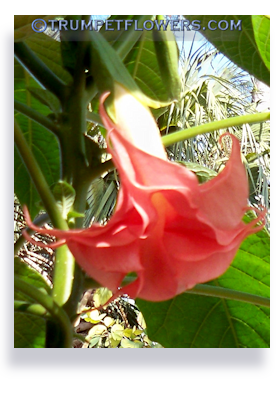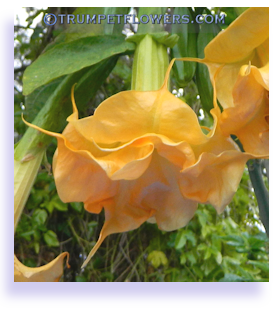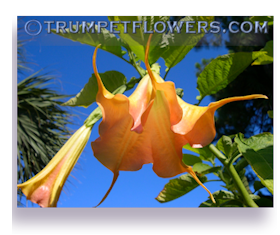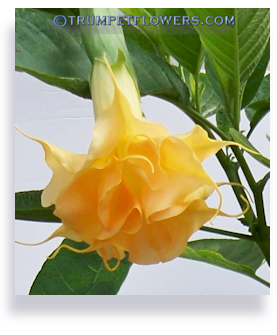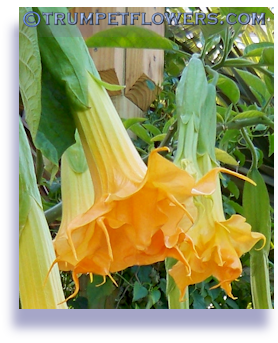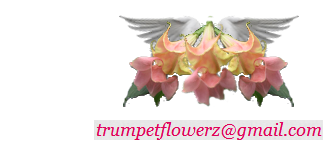Revitalize
Brugmansia
 If your brugmansia is beginning to wane, or spring has come around and it is time to wake your Angel Trumpet's from their winter slumber, there are many different things you can do to help enliven, invigorate, or stimulate it and have it return to normal growth and output of many flower flushes spring through fall. It just takes a little knowledge, a little help (if it is a larger plant) and a little money.
If your brugmansia is beginning to wane, or spring has come around and it is time to wake your Angel Trumpet's from their winter slumber, there are many different things you can do to help enliven, invigorate, or stimulate it and have it return to normal growth and output of many flower flushes spring through fall. It just takes a little knowledge, a little help (if it is a larger plant) and a little money.
Begin by accessing what is wrong with the angel trumpet. Is it being attacked by insects, or is it a fungal or viral problem? If it is pests, you can cure this several different ways, depending upon the pest. If they are large enough, they can be hand picked or sprayed with a strong spray of water to remove them. Repeating this several days a week for a few weeks can get rid of them for good, and allow the plant to return to it's original vigor.
Neem Oil can be used to control aphids and whiteflies. You must do this religiously for a week or so, and while the plants are not wet on the leaves with any other spray than the Neem. If you stay at it, it should wipe them out. Neem Oil also helps control ants and aphids, if used as mentioned above.
There are chemicals that control pests, but since I am against using chemicals unless absolutely necessary, I can only suggest a few you to you.
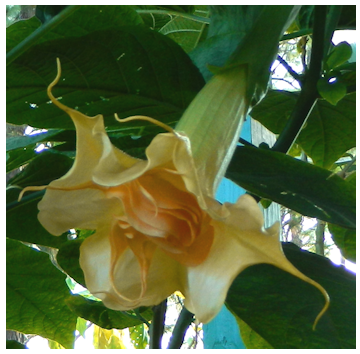 Some gardeners have come up with a pretty inventive method of controlling them. If you have access to a handheld, battery operated vaccuum cleaner, like those made for cars, try sucking the little devils up instead of spraying. Then just leave them to die
in the vaccuum, instead of sucking on your plants.
Some gardeners have come up with a pretty inventive method of controlling them. If you have access to a handheld, battery operated vaccuum cleaner, like those made for cars, try sucking the little devils up instead of spraying. Then just leave them to die
in the vaccuum, instead of sucking on your plants.
It also helps to understand a whiteflie's complete lifecycle. It's a little scary to we gardeners, but the more knowledge you have, the better you are prepared for a first attack. Here is an excellent University of Davis link with photos and complete information on this terrible pest UCDavis, Whitefly Life Cycle.
SPIDERMITE TREATMENT THAT WORKS
Spidermites are notorious pests of brugmansia, especially in drier conditions. Their presence is known when leaves curl, and you see the silk strands from plant to plant.
Forbid is a great chemical if you have a place where you can contain the plant and spray it away from other living things, say in a green house. It will kill the dreaded spidermites that love our brugmansia so much, and the other insects listed above will succumb to it too. Just make sure that butterflies, treefrogs, and anoles cannot come in contact with the plant while it is being treated. Also keep the plant away from canals or other water sources that could potentially flush some of the chemical into the waterways or near you butterfly plants. Forbid is available for large commerical nurseries, but brugmansia clubs like BGI regularly pool together and break down the costs so that small growers are able to easily afford a bottle. Great stuff, just heed all warnings!
You do not have to join Brugmansia Growers International to shop at their online store. Here' the link: BGI Classifieds
If you can't find them on sale at BGI for the regular 20.00, 25.00 bucks, and cannot afford the pricier big bottles, try using Bayer Insect Disease and Mite Control. I just used it for the first time, and it really did do the trick. Locally available in the states too.
There is more on these and other chemical uses to protect your plants on the page Insect Pests and how to eliminate them.
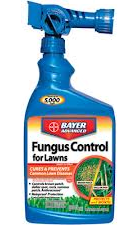
Is it a fungal issue? These can be a bit harder to solve. Fungal problems can usually be remedied using anti∼fungals like Actinovate as an in∼soil additive. This naturally occuring bacteria actually thrive on fungi, and eat them, changing them into a harmless source in the soil that will no longer hurt your brugmansia. Try it if you think this is the problem, and give it a few weeks to see if there are any effectual changes in the vigor of the brug. If so, excellent. If you still have a problem, you may need to move up to more powerful, chemical means of removing the fungal issues.
For those stronger fungal problems, try Bayers product shown above. This stuff works, and is available at Home Depot and Lowes. Sometimes I see it at Walmart or Target.
If you have a viral problem with the plant, identifying the exact virus can be costly, and 99 percent of them are uncureable. If you think your plant has a virus, remove it immediately from any other brugs in the collection (and away from any plants in the family solanaceae) and destroy it with fire if possible. I would not suggest reusing the soil it sat in either. Viruses can lie in wait in many other areas that were inhabited by your brugmansia, and make any other plant it comes in contact with sick too. Just get rid of it! It is not worth it to infect the rest of your collection. They are replaceable, but having the rest of your growing collection coming down with an incureable viral infection will make you a lot sadder than you are by just losing one plant. You can help prevent any problems before they occur by using the product I use, below.
 Bacterial problems are similar to viral, but a few can be solved. For them, try the chemical made by Bayer.
Be sure that you follow the package (bottle) directions as far as keeping the granules away from water sources, pets, children, and never use on food crops. I am going to go against one thing they do say not to do, and advise you to do it. I regularly place it on potted brugs if they need it. I do not place it on the smaller plants, only the ones in the 20 gallon pots, and use the recommended amounts for a plant of the canopy width suggested. I have had no ill effects from mis∼using the product in this manner. By the way, the actual name of the product is Bayer Disease Control.
Bacterial problems are similar to viral, but a few can be solved. For them, try the chemical made by Bayer.
Be sure that you follow the package (bottle) directions as far as keeping the granules away from water sources, pets, children, and never use on food crops. I am going to go against one thing they do say not to do, and advise you to do it. I regularly place it on potted brugs if they need it. I do not place it on the smaller plants, only the ones in the 20 gallon pots, and use the recommended amounts for a plant of the canopy width suggested. I have had no ill effects from mis∼using the product in this manner. By the way, the actual name of the product is Bayer Disease Control.
And for more on a systemic insect pest control, try this stuff. It lasts for a year, which is pretty good. For 20 bucks, I am able to treat almost my entire collection for that year.
Now that we have gone over the pests, viral, fungal, and bacterial problems that may have kept your brugmansia from performing at it's peak, let's get to the real meat of the matter and assume there is really not much at all wrong with the plant, save for some neglect and perhaps you have not been repotting it as you should have.
Ask yourself if you are fertilizing the plant often enough? Brugmansia are notorious eaters, so make sure this is not the problem by getting the plant on a regular fertilizing routine. Foliar feeding will also snap a brugmansia back, I cannot stress enough the difference that adding this to your routine care will make in the health and vigor of your angel trumpets. If after a few weeks, the plant is beginning to recoop, you have solved your issue.
Azomite is a clay dust that contains all micro and macronutrients, and should not be overlooked if you are working with a weakened plant. Keyword it in google, it is available in 2 lb. bags at Amazon, and sometimes locally at better prices in 44 lb. bags.
Brugmansia that can take the dog days of summer heat
Some cultivars of brugmansia just stand up better to the intense heat of summer. From my own experience, I can name Cathedral, Berstein, Kleine Lady, Madeline, Santa Rosa, Fleming Island Rachel, Dalai Lama, Jacayna, Mango Crush as a few that seem not to wilt as much as some others. These brugmansia are more tolerant of our South Florida climate. But all brugmansia love moisture, so water them very well, more than once a day, during strong heat spells.
Brugmansia have the amazing ability to adapt to heat too, so as your smaller plant matures and gets acclimated to it's new environment, most will withstand these few months and then thrive as the weather drops back under 80 degrees.
Repot Brugmansia
If the plant has been in the same pot for a season or more, this may well be what is wrong with it. If you can see roots coming out the bottom of it's container, or it blows over easily in the wind, you have a potting issue. Brugmansia are such fast growers, they will completely eat the soil they sit in if you don't repot it every season or so. This can be seen by an abundance of feeder roots on the surface of the pot, and no soil. Time to repot. Thankfully, this is fairly easy to solve, and brugmansias are very resilient.
To repot brugmansia, (or other small trees or shrubs) plan ahead. Do it in the morning, and a cloudy or misty∼dewy morning is best. Do this in the shade. Do it while temperatures are under 80°, preferably 65° to 70° is best. Doing this in early spring or late fall is the best time of year, but it can be done other times of the year if your plant is in desperate need of being repotted.
Now get a few things together. First, a planter that is two or three times larger than the pot the plant is coming out of. Next, good, humusy soil that is rich with loam, peat, some compost and perlite. Make sure to add the right amount of Osmocote micronutrient beads to the soil mix. You will need a set of good pruners that are sterilized in alcohol first, some gloves if you don't want dirt under your nails, a garden hose, and a spray bottle filled with foliar kelp mixture (liquid, of course) Purchasing a small bottle of Superthrive to mix into a watering can is also a good idea. If you can't find Superthrive, use a tablespoon of unsulphured dark molasses per gallon.
First, turn the pot on it's side and note any large, thick roots that may be coming through the bottom of the pot. If you cannot easily get them back up through the holes of the pot when lifting the plant and soil out, cut them. First roll the pot around on it's side and gently press, even lightly punching it to loosen the soil. The plant should easily remove if it is rootbound.
After you remove it, set the plant down on it's side. Now, grasp the trunk close to the base, but not all the way down, and begin to beat the roots on the ground surface. This is to loosen them, and remove some of the soil that still clings to them.
Now take the pruners and cut, starting at the top of the root base, all the way down and about 4 inches or so inwards, if the plant is large and being removed from say, a 10 or so gallon pot. Do this the entire way around the roots, until you have about 1/3 less of the roots on the outer surface as before. Don't forget the bottom, cut that too.

 When repotting any size brugmansia, just as other plants, only go up 1 to 3 pot sizes. I pot mine up first in 1 quart pots if a small cutting, to 1 gallon for larger, tunk cuttings. When roots are coming out bottom of 1 quart, they move to 1 gallon. From 1 gallon I move to 3 gallon, and from there I start going higher, from 3 to 10, from 10 to 25 gallon. I skip pot sizes as the root mass enlarges, as Angel Trumpets are notoriously fast growers if fed well, and I'd be repotting them at that size once every 4 to 6 weeks. (I fertilize mine like crazy) When brugmansia hit 3 gallon pot size and fully root that pot, they are large enough to place in the ground. I never put a brugmansia in the ground that has not fully rooted a 3 gallon pot.
When repotting any size brugmansia, just as other plants, only go up 1 to 3 pot sizes. I pot mine up first in 1 quart pots if a small cutting, to 1 gallon for larger, tunk cuttings. When roots are coming out bottom of 1 quart, they move to 1 gallon. From 1 gallon I move to 3 gallon, and from there I start going higher, from 3 to 10, from 10 to 25 gallon. I skip pot sizes as the root mass enlarges, as Angel Trumpets are notoriously fast growers if fed well, and I'd be repotting them at that size once every 4 to 6 weeks. (I fertilize mine like crazy) When brugmansia hit 3 gallon pot size and fully root that pot, they are large enough to place in the ground. I never put a brugmansia in the ground that has not fully rooted a 3 gallon pot.

Stand the plant up if possible, next to the new pot. Eyeing it, see about how much soil you need to place in the new pot to get the plant at about the same soil height in the new planter. Thankfully, with brugmansia this is not an exact science. If you think the height of the plant is too tall, intentionally leave less soil in the bottom of the new pot so you can bury more of the trunk and shorten it. It will not harm the brug in any way. You cannot do this with other types of trees, just bruggies!
Place the brugmansia into the new pot with soil added to bottom, and begin filling in around the sides. Be sure you slightly firm it as you go, but do not pack it. Continue until the plant is completely repotted in the new soil. Water thoroughly once, until the water comes out of the drainholes in the bottom of the pot. Now use the shower option on the hose∼head, and clean all the leaves and the trunk and branches. Remove any leaves or buds that were broken in the process.
Now prune the plant about 1/3, to match the rootball's removal amount. This will cause less stress to the plant and stimulate new growth.
Make sure the brugmansia remains in the shade for an hour or so, and then spray it with the kelp foliar feed, if temperatures are below 80°.
That's it. Keep the plant in a more shaded area for the next couple of weeks, until you see it perk up and start some new top growth. Then move it back into a sunnier location. Within a week or so you will notice strong, new growth and within a month to 6 weeks, you should have flower buds.

Tags: revitalize your brugmansia, brugmansia blooms, revitalize brugmansia,invigorate angel trumpets, stimulate brugmansia, repot brugmansia, potting up brugmansia, foliar feed brugmansia, brugmansia, perk up brugmansia, rootbound, repot, bury trunk,
This entry was posted on February 10th, 2012 and is filed under Brugmansia Information.

